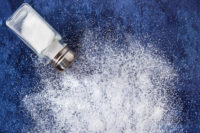
by Donna Berry
In case you were not listening this past year, sodium has become one of a number of evils in the food industry. As a result, food manufacturers are aggressively trying to reduce the sodium content of their offerings in order to appeal to the nutrition label-savvy consumer.
The police are on it
It only takes one voice, and when it comes to the controversies surrounding sodium, the loudest voice in the food industry made it a priority to be heard by the masses. That’s right, according to the Center for Science in the Public Interest (CSPI), the Washington, D.C.-based consumer advocacy group often referred to as the “food police,” the single most dangerous ingredient in the food supply is salt, which is a concentrated source of sodium.
For the past five or so years, the group has used various media outlets to inform consumers about the evils of salt, despite differing opinions among some medical and nutritional authorities regarding the correlation of sodium intake with human health and wellness.
Regardless of how scientifically valid CSPI’s opinion is, it has received attention — and federal support, and now the food industry is responding. This includes meat processors, who often rely on salt to improve the quality and extend the shelf life of different raw cuts, as well as enhance the flavor and texture of cooked products, including processed meats.
Understanding salt and sodium
In order to lower sodium content, one must understand salt’s chemistry, and the functionalities sodium brings to meat. For starters, sodium and salt are not the same. The chemical name for salt is sodium chloride, indicating that sodium is a component of salt. Because sodium is a smaller molecule than chloride, sodium chloride is 39.34% sodium and 60.66% chloride on a molecular weight basis. Food & Drug Administration (FDA) standards also allow table salt to contain up to 2% additives, such as anti-caking agents and processing aids.
Compared to other minerals, the human body needs sodium in relatively large amounts, but many believe not as much as currently consumed. Federal guidelines say the average American should consume about 2,300 milligrams of sodium daily, while some population segments should consume closer to 1,500 milligrams.
According to the American Medical Association, most Americans consume more than 4,000 milligrams each day. Studies suggest that this excessive consumption is a contributing factor to hypertension, heart disease and even certain cancers.
What many sodium-reduction enthusiasts do not fully understand is that sodium’s role in many foods is so much more than flavor enhancer. In fact, in many applications, sodium chloride is a functional ingredient, and careless reduction can have a deleterious effect on quality and safety.
More than a salty taste
Most meats naturally contain 50 to 70 milligrams of sodium per 100 grams. So, in order to manage sodium levels, it is important to know all the sources of sodium. Salt typically contributes the most sodium to meat, followed by phosphates and lactates, each of which makes unique contributions to the quality of meat.
Salt is most often added to meat in the form of a brine or marinade. These highly concentrated sodium solutions are absorbed by the protein through a process called osmosis. The sodium denatures protein molecules, causing them to unwind and form a matrix to trap water. This tenderizes the meat, which results in a juicier cooked protein. Further, flavoring added to the brine is carried into the protein with the saltwater mixture. And, as I previously stated, sodium assists with shelf life and food safety, as sodium is a natural preservative that prevents the growth of both spoilage and pathogenic microorganisms by reducing the water activity to the point where not enough is available for their growth.
Sodium’s numerous roles suggest that many variables must be addressed when sodium is reduced in meat products. There is no magic bullet, and most processors are learning that they must incorporate a combination of sodium-replacement technologies to get the best end product.
For example, potassium phosphates can substitute for sodium phosphates in brines and marinades, as they work synergistically with added salt. There are now a number of highly soluble potassium phosphate ingredients in the market, which deliver the combined synergies while at the same time reduce the sodium quantity. However, there is a slight bitterness associated with potassium, but flavorings and seasonings can be added to mask such off-flavors. Another option is to introduce the mineral magnesium along with potassium. Magnesium has been shown to decrease bitterness and at the same time enhance flavor and provide similar functionalities as sodium.
Cured and processed meats also typically contain relatively high levels of sodium. Blends of potassium and sodium pyrophosphates allow for a significant reduction in sodium, as compared to when standard sodium phosphates are used. Such phosphate blends can also function as a binder in deli meats, allowing processors to achieve improved yield, texture and sliceability. They help prevent lipid oxidation, too, thus extending shelf life by retaining fresh flavor.
With many sodium-reduction options in the market, and more technologies sure to emerge this year, make a resolution to reduce in 2011. Happy New Year!



Report Abusive Comment